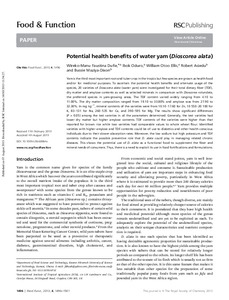| dc.identifier.citation | Dufie, W., Oduro, I., Ellis, W., Asiedu, R., & Maziya-Dixon, B. (2013). Potential health benefits of water yam (Dioscorea alata). Food & Function, 4(10), 1496-1501. |
| dc.description.abstract | Yam is the third most important root and tuber crop in the tropics but few species are grown as health food and/or for medicinal purposes. To ascertain the potential health benefits and alternate usage of the species, 20 varieties of Dioscorea alata (water yam) were investigated for their total dietary fiber (TDF),
dry matter and amylose contents as well as selected minerals in comparison with Dioscorea rotundata, the preferred species in yam-growing areas. The TDF content varied widely ranging from 4.10 to 11.00%. The dry matter composition ranged from 19.10 to 33.80% and amylose was from 27.90 to 32.30%. In mg kg 1, mineral contents of the varieties were from 10.10–17.60 for Zn, 10 550–20 100 for K, 83–131 for Na, 260–535 for Ca, and 390–595 for Mg. The results show significant differences (P > 0.05) among the test varieties in all the parameters determined. Generally, the test varieties had lower dry matter but higher amylose contents. TDF contents of the varieties were higher than that reported for brown rice while two varieties had comparable values to whole wheat flour. Identified varieties with higher amylose and TDF contents could be of use to diabetics and other health conscious individuals due to their slower absorption rates. Moreover, the low sodium but high potassium and TDF contents indicate the possible preventive role that D. alata could play in managing related chronic
diseases. This shows the potential use of D. alata as a functional food to supplement the fiber and mineral needs of consumers. Thus, there is a need to exploit its use in food fortifications and formulations.Yam is the third most important root and tuber crop in the tropics but few species are grown as health food and/or for medicinal purposes. To ascertain the potential health benefits and alternate usage of the species, 20 varieties of Dioscorea alata (water yam) were investigated for their total dietary fiber (TDF),
dry matter and amylose contents as well as selected minerals in comparison with Dioscorea rotundata, the preferred species in yam-growing areas. The TDF content varied widely ranging from 4.10 to 11.00%. The dry matter composition ranged from 19.10 to 33.80% and amylose was from 27.90 to 32.30%. In mg kg 1, mineral contents of the varieties were from 10.10–17.60 for Zn, 10 550–20 100 for K, 83–131 for Na, 260–535 for Ca, and 390–595 for Mg. The results show significant differences (P > 0.05) among the test varieties in all the parameters determined. Generally, the test varieties had lower dry matter but higher amylose contents. TDF contents of the varieties were higher than that reported for brown rice while two varieties had comparable values to whole wheat flour. Identified varieties with higher amylose and TDF contents could be of use to diabetics and other health conscious individuals due to their slower absorption rates. Moreover, the low sodium but high potassium and TDF contents indicate the possible preventive role that D. alata could play in managing related chronic
diseases. This shows the potential use of D. alata as a functional food to supplement the fiber and mineral needs of consumers. Thus, there is a need to exploit its use in food fortifications and formulations.Yam is the third most important root and tuber crop in the tropics but few species are grown as health food and/or for medicinal purposes. To ascertain the potential health benefits and alternate usage of the species, 20 varieties of Dioscorea alata (water yam) were investigated for their total dietary fiber (TDF),
dry matter and amylose contents as well as selected minerals in comparison with Dioscorea rotundata, the preferred species in yam-growing areas. The TDF content varied widely ranging from 4.10 to 11.00%. The dry matter composition ranged from 19.10 to 33.80% and amylose was from 27.90 to 32.30%. In mg kg 1, mineral contents of the varieties were from 10.10–17.60 for Zn, 10 550–20 100 for K, 83–131 for Na, 260–535 for Ca, and 390–595 for Mg. The results show significant differences (P > 0.05) among the test varieties in all the parameters determined. Generally, the test varieties had lower dry matter but higher amylose contents. TDF contents of the varieties were higher than that reported for brown rice while two varieties had comparable values to whole wheat flour. Identified varieties with higher amylose and TDF contents could be of use to diabetics and other health conscious individuals due to their slower absorption rates. Moreover, the low sodium but high potassium and TDF contents indicate the possible preventive role that D. alata could play in managing related chronic
diseases. This shows the potential use of D. alata as a functional food to supplement the fiber and mineral needs of consumers. Thus, there is a need to exploit its use in food fortifications and formulations. |

